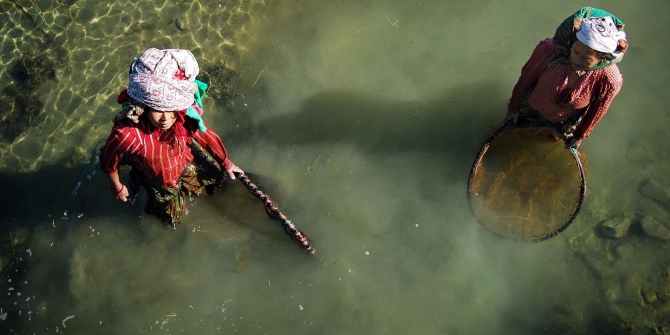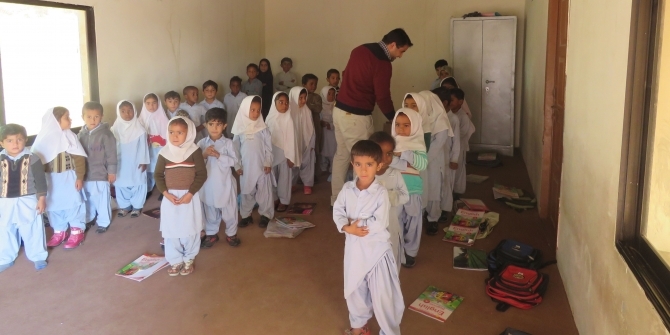 In Pakistan, some 15,000 youngsters turn 18 each day and will be eligible to vote in this year’s election. What lies ahead for South Asia’s second youngest country and its booming youth population? Hina Shaikh gives a detailed overview, the challenges and opportunities.
In Pakistan, some 15,000 youngsters turn 18 each day and will be eligible to vote in this year’s election. What lies ahead for South Asia’s second youngest country and its booming youth population? Hina Shaikh gives a detailed overview, the challenges and opportunities.
A much-delayed decline in fertility levels has resulted in Pakistan becoming the second youngest country in South Asia, with nearly two-thirds of its 207.8 million population under the age of 30.
This youth bulge presents an unprecedented, but time-bound, window of opportunity to Pakistan in the shape of a ‘demographic dividend’, which may not arise again for several generations. UNICEF estimates the youth population (aged 15-24) now forms close to 36 per cent of Pakistan’s labour force, projected to rise to 50 per cent by 2050. Fertility rates are still high at 3.55 and working-age population is expected to continue growing even beyond 2050.
Unlike South East Asia, where the youth’s economic potential was identified in hindsight, with appropriate and urgent policy responses Pakistan may be in a better position to leverage the youth dividend.
As many educated Pakistani youngsters go without a decent job, it is not hard to imagine an uprising akin to the Arab Spring in Pakistan. Dealing with a rising youth population is not without monumental challenges even as it presents unique opportunities.

Economic growth to create jobs
World Bank estimates that in the last decade, youth unemployment in Pakistan has exceeded the overall rate of unemployment. Labour Force survey 2014-15 shows around 4 million people aged 15-24 are unemployed. This number is expected to rise by 2020 to 8.6 million. World Bank further predicts the annual entry of at least 1.7 million people into the job market up to 2040, assuming an annual population growth rate of 2.07 per cent. This figure is likely to go up as the census reveals a higher growth rate of 2.4 per cent.
A consistent GDP growth rate of over 7 per cent is required to absorb the young workforce. The government has set a growth rate target of 6 per cent for 2017-18. Not only does Pakistan need faster economic growth, it also needs a kind of growth that scales-up employment opportunities. Every job in manufacturing for example creates 2.2 jobs in other sectors. Yet, value added manufacturing’s share in GDP has fallen from 14.5 per cent in 2012 to 12.8 per cent in 2015.
With almost 30 million of the 50 million people aged 18 to 29, residing in Lahore and Karachi alone, the demographic challenge is even more serious in the cities. While human capital development and placement in productive employment is skewed in favour of cities, a large number live in squatter settlements, energy use is expected to quadruple and clean drinking water is becoming scarce. Hence, economic growth has to translate into planned urbanisation to address growing pressure on Pakistan’s limited urban resources.
Quality of jobs
The employment challenge is not limited to generating more jobs but also extends to ensuring ‘gainful/productive’ employment. Job creation in Pakistan has had disappointing labour market outcomes. At least 25 per cent of the youth is engaged in unstable, low-paid employment without any benefits and 35 per cent (majority women) in unpaid family work. The continued shortage of skilled workers, despite a rising workforce, is pushing more people into unemployment or informal work. Less than a third of the labour is employed in the formal sector.
Creation of poor quality jobs is closely associated with low labour productivity. Growth in labour productivity fell from 4.2 per cent during the 1980s to an average of 1 per cent since 2007. Low productivity is a manifestation of the poor quality of workforce, sluggish growth in investment as a share of GDP and a slow shift towards high-value added sectors (like manufacturing) from low-value added (such as in agriculture).

Education and skills
Young entrepreneurs are essential to the creation of good quality jobs. This cannot be achieved when only 12 per cent of Pakistan’s youth graduate beyond grade 12. Pakistan has one of the lowest spending on education, hovering around 2 per cent of the GDP, in South Asia. It is also among the world’s top ten countries with the highest number of out of school children – estimated at 22.6 million — while around two fifths of its working age population remains uneducated. To achieve 100 per cent primary enrolment by 2030, Pakistan will have to increase its enrolment rate by four times.
Skill acquisition to offset educational deficits and ensure productive employment remains inadequate especially in poorer districts and for youngsters without formal schooling. Only 1.3 per cent of those entering the job market each year have vocational training.
Opportunities
Some economic benefit of the demographic transition has already begun accruing to Pakistan’s economy as the youth drives consumption in communication, electronics and retail, leading to a noticeable market expansion. Planet Retail, forecasts an annual 8 per cent growth in Pakistan’s retail market currently estimated at $152 billion.
Increase in remittances via export of skilled, as opposed to semi-skilled or unskilled labor is another key opportunity. The remittances sent by overseas Pakistanis witnessed an aggregate annual growth of 8.2 per cent between 2013 and 2017. By allowing rich countries to outsource specialised services, Pakistan can potentially earn foreign exchange worth $20 billion in the IT sector alone.
Youth vote as a driver of reform
At the time of the 2013 general election, a fifth of Pakistan’s 85 million registered voters were under 25 while 15 per cent between 26 and 30. Since then some 15,000 people are turning 18 each day, adding 10 million people to the voters list until the 2018 general elections. Young people value service delivery that responds to its needs: better health, better education, more jobs, clean drinking water to name a few. The incumbent and future government’s desire to capture the youth vote may drive the desire to tap into the youth’s aspirations and push for required reform.
Looking for solutions
Realisation of the demographic dividend is intrinsically connected to a) enhancing the economy’s capacity to absorb the young workers into productive employment, b) profound investments in education and skills training and c) empowering them to engage meaningfully across the social and political landscape. Policy actions for achieving these objectives must be underpinned by three fundamental principles.
The solutions have to be inclusive. It will be harder to leverage the demographic dividend without adequately focusing on the female youth. At 22 per cent, Pakistan has one of the lowest rates of female labour force participation in the world. Ongoing research on urban mobility to encourage women’s economic participation can help design suitable policies.
Governments have to encourage engagement with the private sector. Punjab has taken the lead by setting up the Punjab Skills Development Fund (PSDF), providing skills training in collaboration with private companies.
An integrated framework/policy is required to address youth development as a cross-sectoral issue. Pakistan currently lacks a national youth policy or a federal entity, post-devolution, to spearhead efforts for the youth. Policy interventions such as the internship programme, handing out of free laptops , and several other schemes under the Prime Minister’s youth programme, will generate only short-term solutions unless they are embedded in an overall reform to push for sound delivery of basic services, including interventions in education, skills, health, and labour.
This article gives the views of the author, and not the position of the South Asia @ LSE blog, nor of the London School of Economics. Please read our comments policy before posting.
About The Author
 Hina Shaikh is a Development Specialist who is currently working as a country economist at the IGC. Her research interests include public policy in the social sector, particularly education, role of the public and private sector in service provision and financing, understanding and analysing poverty (including gendered poverty) and development in developing countries and political economy of governance and economic reforms. She tweets @hinanshaikh
Hina Shaikh is a Development Specialist who is currently working as a country economist at the IGC. Her research interests include public policy in the social sector, particularly education, role of the public and private sector in service provision and financing, understanding and analysing poverty (including gendered poverty) and development in developing countries and political economy of governance and economic reforms. She tweets @hinanshaikh







